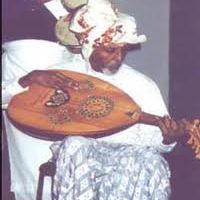Abdullahi Qarshe
Abdullahi Qarshe عبدالله قارشي | |
|---|---|
 | |
| Background information | |
| Birth name | Cabdilaahi Qarshe |
| Born | 1924 Moshi, Tanzania |
| Origin | Somali |
| Died | 1997 (aged 72–73) |
| Genres | Balwo, Heello, Qaraami |
| Instrument(s) | Oud, piano, guitar, lute |
| Years active | 1940s–1970s |
| Labels | Wadani |
Abdullahi Qarshe (Somali: Cabdilaahi Qarshe, Arabic: عبدالله قارشي) (1924–1994) was a Somali musician, poet and playwright known as the "Father of Somali music".[1] In 1957 he wrote and composed the Somali National Anthem, Qolobaa Calankeed.[2]
Biography
Qarshe was born in 1924 in the Somali expatriate community in Moshi, Tanzania. He belonged to the Habar Yoonis sub clan of (Garhajis) Isaaq that mainly inhabits Sanaag region of Somaliland.[3] In 1931, at the behest of his family, he left Tanzania and settled in Aden, Yemen for his education. It is in Aden where Abdullahi had his first encounter with cinema and radio playing western films and Indian and Arabic music, which inspired him to buy a lute to accomplish his new goal of creating music in the Somali language. He was married to Adaiya Qarshe whom he had four children with, Rukiyo Qarshe, Safiyo Qarshe, Anab Qarshe and Mahad Qarshe.
Qarshe, along with other first generation artists such as Ali Feiruz and Mohamed Nahari, was among the pioneers of modern Somali music. An innovative musician, Qarshe often employed a wide variety of instruments in his art, such as the guitar, piano and oud. He was also known for his poems and his theatrical work at Mogadishu and Hargeisa venues.
Matters began to change following World War II as musicians and composers, like Abdullahi qarshe, popularly known as the father of somali music, began to pioneer a new genre- that of Balwo and Heello, both of these terms refer to forms of lyrical verse, the difference between the two being that balwo is four lines only while heello is considerably longer. Both styles broke new grounds in style and content. the subject matter differed radically from the past, as compositions focused in on love and nationalism, rather than the epic tales of war and adversity as in the old hees, at least some of this shift can be accredited to Elmi Boodhari, a baker who composed during the 1930s. he is said to have recited his compositions describing his unrequited love for a woman named hodan until he wasted away and perished in 1941. ~ Africa: An Encyclopedia of Culture and Society [3 volumes]: An Encyclopedia of Culture and Society[4]
Qarshe introduced a new and shorter form of Heello by combining traditional Somali poetry with song. In the 1940s he created his first song Ka ka'ay (Arise). Qarshe utilized many of his Heello songs to express Pro-independence and anti-colonial sentiments. In tribute to Patrice Lumumba he wrote the song Lumumba ma noole mana dhimane (Lumumba is not alive neither is he dead) in 1960 . In 1957 he composed the current Somali National Anthem Qoloba Calankeeda waa cayn (Every nation has its own unique flag). In 1955 Qarshe founded the Walaalo Hargeisa troupe which performed various plays around Somalia, one of them being Soomaalidii Hore iyo Somaalidii dambe (Somalis present and past). Qarshe's 1961 song Aqoon la'aan waa iftiin la'aan(to be without knowledge is to be without light) was the signature tune of Radio Mogadishu. In addition, Qarshe was a member of the pioneering Somali musical ensemble Waaberi.[5][6][7]
See also
Notes
- ^ Johnson, p.82
- ^ "The Statesman's Yearbook 2014: The Politics, Cultures and Economies of the World, by Barry turner , p.1116".
- ^ http://www.fao.org/fileadmin/user_upload/drought/docs/Renders%20Terlinden%20Somaliland%20Statehood%202010.pdf
- ^ "Africa: An Encyclopedia of Culture and Society, p.1102".
- ^ "Hisorical Dictionary of Somalia by Mohamed Haji Mukhtar. pp. 13-14".
- ^ "The CIA world factbook 2007, p.778".
- ^ "The Statesman's Yearbook 2014: The Politics, Cultures and Economies of the World, by Barry turner , p.1116".
References
- Johnson, John William (1996). Heelloy: modern poetry and songs of the Somali. Indiana University Press. ISBN 1-874209-81-2.
